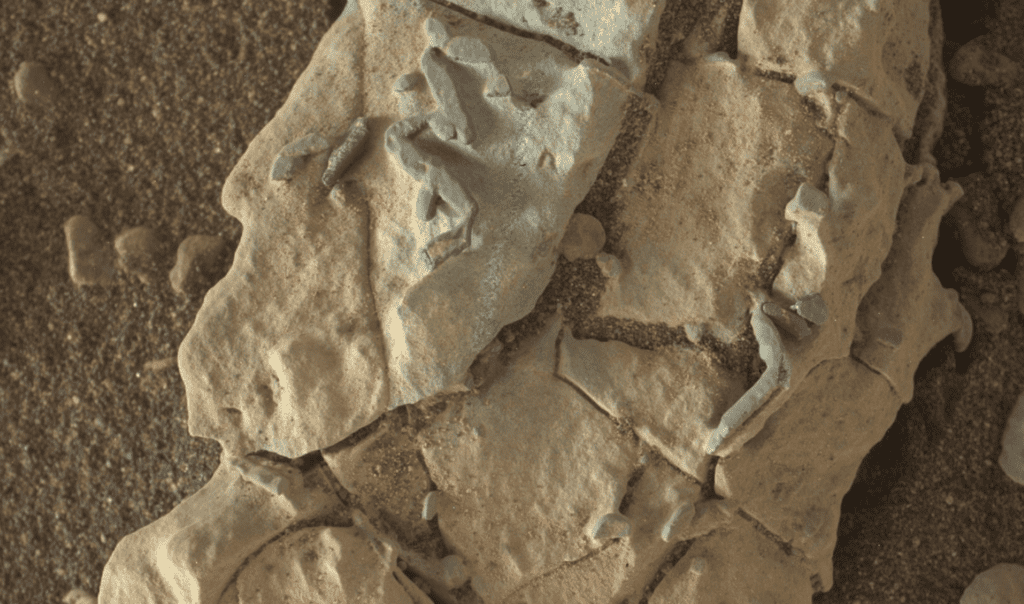If you were excited about the signs of life reportedly spotted on Mars, it’s might be time to reign in your expectations. The tube-like structures identified by Curiosity were probably formed by geology, not biology, mission team members say.

The troublesome structures captured by Curiosity on Jan. 2, 2018, using its Mars Hand Lens Imager. The tubular structures were likely created by crystalline growth, mission team members said.
Image credits NASA/JPL-Caltech/MSSS.
News that Curiosity stumbled upon fossilized traces of life took the Internet by storm a few days ago. And I get it — Mars is just so tantalizingly right for our first encounter with extraterrestrial life, no matter how dead the latter may be. The planet’s dry as a brick now, but we know it used to have water and a proper atmosphere. It’s relatively close-by, enough so that we actually stand a chance of getting there in the mid-future, but it’s still largely unexplored and mysterious as of now. I too, if I may use a cliche, want to believe.
NASA however, as they tend to do, comes to nip those hopes in the bud. The tubular structures spotted on Mars were probably formed by growing crystals, not burrowing creatures, members of the Curiosity mission said.
“When we looked at these things close up, they’re linear, but they’re not tubular in the sense of being cylinders; they’re actually quite angular,” said Ashwin Vasavada of NASA’s Jet Propulsion Laboratory in Pasadena, California.
“They have kind of a square or a parallelogram sort of cross section and form at angles to each other when there’s multiple of them together. And all of that’s pretty reminiscent of crystalline growth.”
The team suspects that the structures are either crystals or molds left in the rock when sediments hardened around pre-existing crystals. While that’s less exciting than finding life, it’s not an inconsequential find at all — both scenarios (the second one a bit more) would require quite a lot of liquid water, suggesting that the area Curiosity is roaming around right now was abundantly wet in Mars’ past. The whole area, a flank of the towering Mount Sharp, is pretty elevated as well — over 300 meters (1,000 feet) vertically above the rover’s initial landing site on Gale Crater.
Curiosity found ample evidence for the existence of a (now dry) groundwater network and an ancient lake-and-stream system on the crater’s floor and along the mountain’s lower slopes. The team is confident that evidence of Mars’ transition from a warm and wet world to the cold, dry place it is today remained locked in the mountain’s rocks. The rover is still to find that transition zone, however, and will continue its ascent until it does so.
Everything considered the chances that this will be our first taste of alien life look slim. It’s not impossible that the tubes are trace fossils of life on Mars, it’s just not very likely given what we know so far. And, as someone who’s gone fossil-hunting in the field, I can confirm that it’s really hard to distinguish trace fossils from weird, but random, shapes left over as geology does its stuff. So making a bullet-proof case that these really are fossils would be extremely difficult on Mars.
“We just, unfortunately, may not have the ability with Curiosity to tell that,” Vasavada said.
The rover has two instruments it can use to analyze the structures. The first is a laser-touting ChemCam, supplemented with the Alpha Particle X-Ray Spectrometer (APXS). These devices can be used to gauge the little tubes’ chemical make-up, but they’ve proven themselves difficult targets. The structures are only about 1 millimeter (0.04 inches) wide by 5 millimeters (0.2 inches) long. Still, Vasavada is confident we’ll have the results within the next week, and with them, we could get the answers we so crave.
Untill then, as the rover tweeted, science continues.
Meanwhile, back on Mars… I’m checking out these stick-like figures. Each is about a quarter-inch long. Maybe they're crystals? Or they could be minerals that filled spaces where crystals dissolved away. Stay tuned! Science continues. pic.twitter.com/4oR70BVht3
— Curiosity Rover (@MarsCuriosity) January 4, 2018









